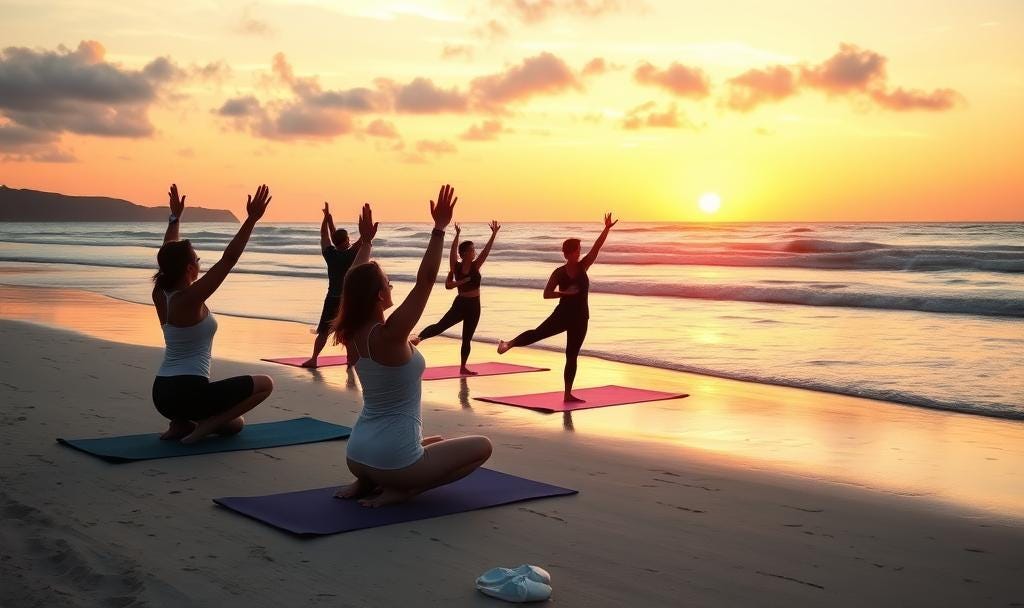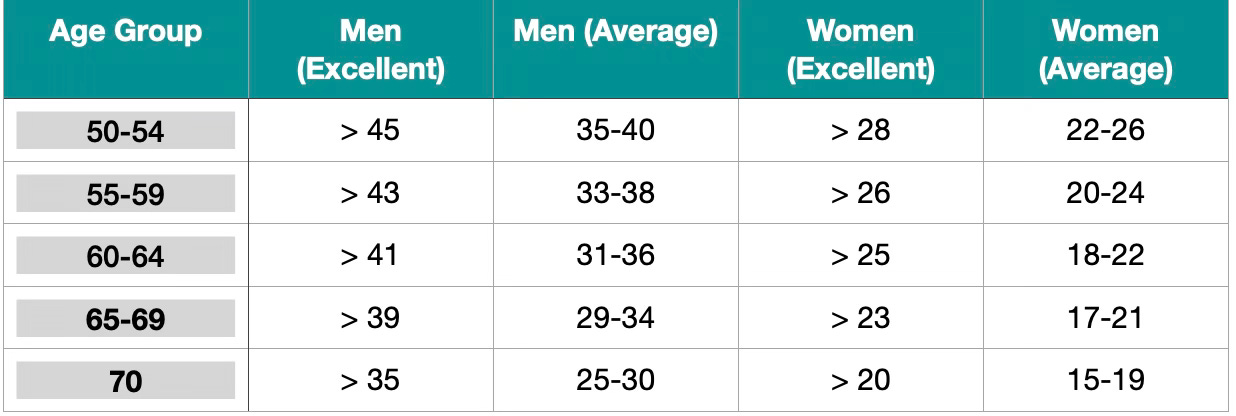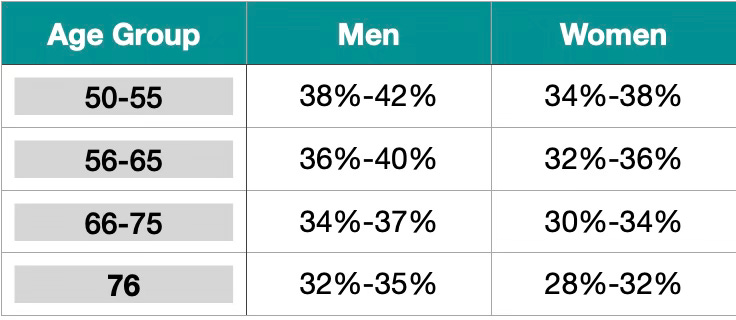How to Assess Your Own Fitness and Longevity Potential - Part 1
Evaluation of Aerobic Fitness and Muscle Strength
Educational only, not medical advice - See full disclaimer.
Imagine that you're in your 50s, feeling pretty good overall, but suddenly notice that climbing a flight of stairs leaves you more tired than it used to. Or you may realize that opening stubborn jar lids has become genuinely challenging. These subtle shifts aren't just minor inconveniences; they're early warning signals about your overall health trajectory and longevity potential.
Join a community of health-conscious readers and subscribe for weekly physician insights.
Self-evaluation isn't about vanity or competition; it's about taking control of your aging process. When it comes to living longer and healthier, knowledge truly is power; specifically, knowledge about your own body's current state and how it changes over time.
The most effective approach to assessing your health goes far beyond stepping on a scale or checking your blood pressure once a year. Sadly, your doctor is unlikely to discuss the methods I will describe below during your once-a-year health check-up.
Why Self-Evaluation Matters for Longevity
Research consistently shows that improvements from poor to moderate health in any category may provide longevity gains. Even more importantly, combining better physical activity, nutrition, sleep, and social engagement can multiply these benefits. This is why a comprehensive self-assessment approach is so valuable: it helps you identify which areas need the most attention and allows you to prioritize your health investments wisely.
The four domains we'll explore (in two article series) - aerobic fitness, muscle strength and mass, flexibility, and balance are all powerful predictors of healthy aging.
Following Changes Over Time: Your Health Trend Line
Perhaps the most crucial aspect of self-assessment is the "over time" component. A single measurement tells you where you are today, but a series of measurements reveals the trend, and the trend is what predicts your future. This is why establishing baseline measurements and then reassessing every 8-12 weeks is so valuable. You'll be able to see if your interventions are working, catch declining function early, and celebrate improvements that might otherwise go unnoticed.
Safety First: Essential Precautions Before You Begin
Before undertaking any fitness assessment, safety must be your top priority. These tests can be physically demanding, and it's essential to approach them responsibly:
Medical Clearance: If you're over 40, sedentary, or have any chronic health conditions (especially cardiovascular concerns, joint problems, or diabetes), consult your healthcare provider before beginning any maximal effort testing.
Proper Warm-Up: Always start with 5-10 minutes of light activity before any fitness test. Your muscles and joints need to be prepared for the demands you're about to place on them.
Listen to Your Body: Stop immediately if you experience chest pain, severe shortness of breath, dizziness, or any concerning symptoms. These are assessments, not competitions; the goal is to gather information about your current fitness level, not to achieve a personal best.
Environmental Safety: Test on non-slip surfaces, ensure adequate space, have stable support within reach during balance tests, and consider having someone nearby for higher-risk assessments.
Know Your Limits: Choose tests that match your current fitness level, and don't hesitate to use modified versions if needed. Remember, the goal is to gather information about your current fitness level, not to prove anything to anyone.
Now, let's explore the first two critical domains that will provide you with a comprehensive understanding of your fitness and longevity potential. Next week, I will cover the remaining two.
Self-Evaluation of Aerobic Fitness: The Foundation of Longevity
Aerobic fitness is a powerful predictor of longevity and healthy aging. Your cardiovascular system is the engine that powers every other system in your body. When your heart, lungs, and blood vessels function efficiently, they deliver oxygen and nutrients to your muscles, brain, and organs more effectively.
This enhanced efficiency translates into improved energy levels, better cognitive function, a stronger immune response, and greater resilience against age-related diseases.
The research is compelling: individuals with higher VO₂ max values (the maximum ability of the body to use oxygen during exercise) have significantly lower rates of cardiovascular disease, diabetes, certain cancers, and all-cause mortality. Even modest improvements in aerobic fitness can add years to your life and life to your years.
The Six-Minute Walk Test
This gold-standard assessment is ideal for adults over 50 because it's self-paced, safe, and highly predictive of health outcomes. Research shows it correlates strongly with laboratory VO₂ max testing while being completely accessible for home use.
Equipment Needed:
Measured a 30-meter course (a hallway works perfectly)
Stopwatch
Chair for rest if needed
How to Perform:
Mark out your course with clear start and finish lines
Walk as far as possible in 6 minutes at your maximum sustainable pace
Turn around at each end of the course (this distance counts)
You may slow down or rest if needed, but the timer keeps running
Record total distance covered
Table 1: Results of 6 minute walk test:
Clinical Significance: Distances below 400 meters indicate significant functional impairment and increased mortality risk. Improvements of 50-70 meters represent significant fitness gains that can translate to a better quality of life and increased longevity.
The Three-Minute Step Test
This classic cardiovascular assessment provides excellent correlation with laboratory fitness testing while requiring minimal equipment. It's also helpful in tracking improvements over time.
Equipment Needed:
12-inch step or sturdy bench
Metronome app (set to 96 beats per minute)
Stopwatch
How to Perform:
Set the metronome to 96 beats per minute (24 steps per minute: up-up-down-down pattern)
Step up and down for precisely 3 minutes, maintaining the rhythm
Immediately after finishing, sit down and measure your heart rate for 1 minute
Record your heart rate
Table 2: Results of 3-Minute Step Test (bpm = heart rate in beats per minute)
Why It Matters: Lower recovery heart rates indicate better cardiovascular fitness and improved longevity prospects.
Cooper 12-Minute Run/Walk Test
For those who can handle moderate to vigorous intensity, this test provides direct VO₂ max estimates with excellent research validation.
Equipment Needed:
Measured track or course
Stopwatch
How to Perform:
Warm up thoroughly with 5-10 minutes of light jogging and dynamic stretching
Run or walk continuously for 12 minutes, covering the maximum distance possible
You can alternate between running and walking, but keep moving for the entire 12 minutes
Record total distance covered
VO₂ Max Calculation:
Metric: VO₂ max = (22.351 × kilometers covered) - 11.288
Imperial: VO₂ max = (35.97 × miles covered) - 11.29
Table 3: Results of Cooper’s Test as VO₂ max in ml/kg/min
Research shows that an increase of approximately 3.5 ml/kg/min in VO₂ max reduces mortality risk by 12%.This information makes aerobic fitness assessment not only informative but also potentially life-saving in terms of motivation for improvement.
Self-Evaluation of Muscle Strength and Muscle Mass
Muscle strength and mass represent far more than physical appearance; they're fundamental to metabolic health, bone density, functional independence, and longevity. Your muscles consume glucose, store energy, and provide the physical foundation for all daily activities.
Muscle strength typically peaks in our 20s and 30s and declines by 3-8% per decade after age 30. However, this decline isn't inevitable. Regular assessment and targeted interventions can slow, stop, or even reverse age-related muscle loss. Remarkably, research shows that low muscle strength is a stronger predictor of mortality than muscle mass alone, making strength assessment particularly crucial as we age.
Grip Strength Test
Grip strength is widely regarded as the most reliable single measure of overall body strength. It is strongly correlated with total-body muscle strength, making it an excellent screening tool for assessing overall body strength. Research shows that grip strength values below 27 kg for men or 16 kg for women indicate an increased mortality risk, demonstrating how a simple strength test can reveal a great deal about overall health.
Equipment Needed:
Hand dynamometer (available online for $30-$60)
How to Perform:
Sit with your arm at your side, elbow bent exactly 90 degrees
Keep your forearm in a neutral position (thumb pointing up)
Squeeze the dynamometer with maximum effort for 5 seconds
Take three measurements with a 1-minute rest between attempts
Test both hands and record the average of three trials for each hand
Table 4: Results of Grip Strength Test (kg force, dominant hand)
30-Second Chair Stand-up Test
This functional strength test assesses lower-body strength and power, which are crucial for maintaining independence as we age. It directly relates to fundamental movements for independent living, like getting out of chairs, cars, and toilets.
Equipment Needed:
Standard chair without armrests (17 inches/43 cm high)
Stopwatch
How to Perform:
Sit in the chair with arms crossed over your chest
Keep your feet flat on the floor
Stand up completely, then sit back down as many times as possible in 30 seconds
Count only complete sit-to-stand-to-sit cycles
Table 5: Results of Chair Stand Test(repetitions):
Important: Studies have shown that better chair stand performance is associated with a 15% lower risk of death. Scores below average indicate increased fall risk and warrant strength training intervention.
Push-Up Test
The push-up test evaluates upper body muscular endurance and provides excellent insights into functional strength patterns.
Equipment needed:
Just your body and a flat surface!
Procedure:
Men: Perform standard push-ups (toes and hands)
Women: Choose modified push-ups (knees and hands) or standard if capable
Count maximum repetitions with proper form (full range of motion, straight body line)
Stop when you can no longer maintain proper form
Table 6: Men (Standard Push-ups - repetitions):
Table 7: Women (Modified Push-ups - repetitions):
Practical Tip: If you can't perform a single standard push-up while exercising, start with wall push-ups or incline push-ups using stairs or a bench. The goal is progressive improvement, not immediate perfection.
Bioelectrical Impedance Analysis (BIA) for Muscle Mass
While strength testing tells us about muscle function, assessing muscle mass provides insights into the underlying muscle tissue itself. Many home scales now include BIA technology to estimate body composition.
Equipment Needed:
BIA-enabled scale (available for $50-150)
How to Perform:
Test at the same time daily (preferably morning)
Use in a fasted state, post-bathroom
Avoid testing after recent exercise or large meals
Ensure proper hydration (but not immediately after drinking large amounts)
Stand barefoot on the scale and input age/height when prompted
Table 8: Muscle Mass Percentage Norms
Important Note: While not as accurate as DEXA scans, BIA scales provide reasonable estimates for tracking trends over time. Focus on trends rather than absolute numbers, and remember that improvements in muscle strength often occur before measurable changes in muscle mass.
Summary:
The assessments covered in this first part - aerobic fitness and muscle strength evaluation - represent the foundation of your health and longevity profile. These two domains provide critical insights into your cardiovascular health and functional capacity. Both are good predictors of healthy aging and mortality risk.
Your Next Steps
Now that you understand how to evaluate your cardiovascular fitness and muscle strength, you can apply this knowledge in practice. Start by selecting one test from each category that matches your current fitness level. Remember, the goal is to gather baseline information, not achieve perfect scores.
What’s Coming Next Week
While aerobic fitness and strength provide crucial insights into your health trajectory, they represent only half of the comprehensive picture of your assessment. In Part 2 of this series, I will explore the remaining two: flexibility and balance assessment.
These two underappreciated components of fitness play essential roles in maintaining functional independence, preventing falls, and supporting quality of life as we age. Next week you will discover practical tests for evaluating your range of motion, joint mobility, and balance control that can be performed at home.












This is such valuable information! Thank you for sharing! I’m going to try this test.